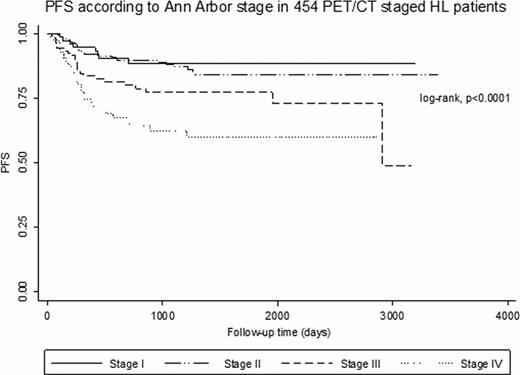Abstract
Abstract 1532
[18]F-fluorodeoxyglucose positron emission tomography/computed tomography (PET/CT) has become the method of choice for staging of Hodgkin lymphoma (HL). Studies indicate that PET/CT has higher sensitivity for both nodal and extranodal disease compared to stand-alone CT, which leads to upstaging of some patients and could potentially change the treatment strategy. The aims of this study were to assess the impact of PET/CT on staging results in newly diagnosed HL and to reevaluate the prognostic impact of the Ann Arbor classification in the PET/CT era.
We performed a retrospective review of pre-therapy staging results obtained in newly diagnosed HL patients before and after the introduction of PET/CT for routine staging at four Danish University Hospitals. Patients with histology verified HL and age ≥15 years were eligible for inclusion. Clinical information and staging results were obtained from the Danish Lymphoma Registry (LYFO) and supplemented by review of medical records. The CT cohort consisted of patients undergoing diagnostic work-up before the implementation of PET/CT (1998–2005). The PET/CT cohort consisted of patients staged with PET/CT during the period of 2006–2011 (for Copenhagen University Hospital 2001–2011). Follow-up data were collected on all PET/CT staged patients. Differences in clinico-pathological features between CT and PET/CT staged patients were tested with Fisher's exact test for categorical variables and Wilcoxon rank-sum test for continuous variables. In the PET/CT cohort, the Ann Arbor stage-specific progression-free survival (PFS) was evaluated by the Kaplan-Meier method and compared using the log-rank test.
A total of 417 patients were included in the CT cohort and 454 patients were included in the PET/CT cohort. The two cohorts were similar on male:female ratio, histological HL subtype distribution and frequency of B-symptoms. The CT cohort differed from the PET/CT cohort in terms of slightly higher median age (42 yrs vs. 39 yrs; p=0.04) and poorer (≥2) ECOG performance score (17.8% vs. 5.3%; p<0.001). Stage I disease was less frequent among PET/CT staged patients (24% for CT vs. 17% for PET/CT, p=0.005), whereas stage II and III disease occurred more often in PET/CT staged patients. There was no difference in the occurrence of stage IV disease (18% for both CT and PET/CT staged patients). The overall frequency of extranodal involvement was 23% in the CT cohort and 26% in the PET/CT cohort (p=0.39). Among patients with extranodal involvement, the number of affected organs in CT vs. PET/CT staged patients was 1 organ: 82% vs. 73%; 2 organs: 16% vs. 25%; and ≥3 organs: 3% vs. 2% (p=0.24). PET/CT staged patients were more likely to be diagnosed with bone/bone marrow involvement (19% for PET/CT vs. 10% for CT, p<0.001), whereas the occurrence of lung/pleura, liver, muscle/soft tissue and gastrointestinal involvement was similar. In PET/CT staged patients, the Ann Arbor stage was predictive of PFS (median follow-up 34 months, range 1–113), although the difference between stage I and II was not statistically significant (Figure 1).
The two main differences between CT and PET/CT staged patients found in the present analysis were a lower occurrence of stage I disease and a more frequent detection of skeletal lesions in PET/CT staged patients. Unexpectedly, the overall frequency of extranodal involvement was similar between the two staging modalities. However, this does not necessarily imply a similar extranodal tumor burden since accurate lesion counts in each organ and volume measurements were not performed. Although developed decades ago, the Ann Arbor staging system still provides useful prognostic information in the PET/CT era.
Hutchings:Takeda/Millennium: Consultancy.
Author notes
Asterisk with author names denotes non-ASH members.


This feature is available to Subscribers Only
Sign In or Create an Account Close Modal